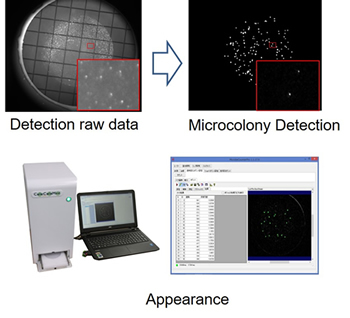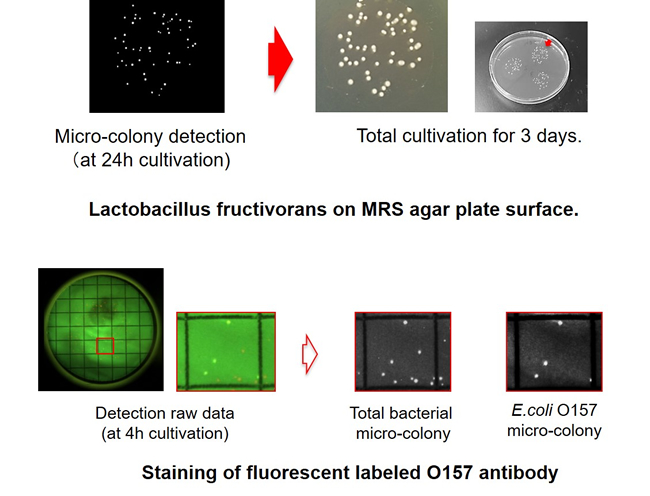
ここからコンテンツです。

Rapid and sensitive bacteria detection using microcolony method combining a fluorescent staining technique and a bioimaging system
By Shigeki Nakauchi
We have developed a novel fluorescent staining method “metachronic observation”. This method consists of taking some metachronic fluorescent staining microcolony data, and comparing it to fluorescent signals in order to provide high definition microcolony signals. In addition, we have developed a novel method for detecting microcolonies which we have termed “membrane covering method”, . This method can be used for staining microcolonies above the agar surface, as well as for staining with fluorescence-labeled antibodies.
Microbiological contamination is a key issue for the pharmaceutical, food and beverage industries. However, traditional methods to detect physiologically active bacteria, such as the standard incubation method, take a long time to produce results. Thus, there is a significant demand for speedier results from microbiological detecting methods . To this end, we conducted research and development on a new method for rapid and defined bacteria detection. This research was supported by the Technological Development Project for Food Safety and Security which was a part of ‘The Knowledge Hub Aichi, Priority Research Project 2’.

To begin with, we evaluated the standard rapid detection method for bacteria. Then, we focused on a membrane filtration method, which is one of the many rapid methods of bacterial detection. In this approach, bacterial cells were trapped on a membrane filter and cultured on nutrient medium. After a brief incubation, viable cells formed microcolonies and were stained with fluorescent staining solution. We identified two key deficiencies of this method as targets for improvement:
- Identification of falsepositive contamination.
- Standard colony incubation afterdetecting microcolonies.
As a result, we have developed a new fluorescent staining method called the “Metachronic observation method” and in addition the “Membrane covering method”. The “Metachronic observation method” consists of taking a number of fluorescent signals at intervals of a short period of around 1~3 min from fluorescent staining microcolonies. Comparison of the fluorescent signals provides high definition microcolony signals, removing noise from the contaminated debris and background. This technique has been used for developing a commercial fluorescent microcolony detection device named “ColoColoMee” produced by Tsuchiya Co., Ltd. Furthermore, we have also developed the “Membrane covering method” as a novel microcolony staining method, which can be used for staining microcolonies above the agar surface using a membrane immersed staining solution, allowing us to stain with fluorescence-labeled antibodies.

Shinichi KAIYA, postdoctoral researcher, said “This research was supported by Technological Development Project by Aichi Prefecture for the development of commercial products. In the beginning then, I worried about how I should approach the development. At that time, we first validated the system using well-known biological detecting methods. Also we targeted the microcolony method and tried to discover a way to resolve certain unsolved problems. Finally, we successfully developed two novel methods for microcolony detection: ‘metachronic observation method’ and ‘Membrane covering method’, and developed a commercial product ‘Microcolony detection system ColoColoMee’. I am very happy about that.”
This developed sytem “ColoColoMee” has now been improved by Tsuchiya Co., Ltd. for commercialization. “ColoColoMee” is the first microcolony detecting device using the “metachronic observation method” and further research into the “Membrane covering method” to develop a new function for the system.
Visual Perception and Cognition Laboratory, Toyohashi University of Technology
http://www.vpac.cs.tut.ac.jp/
Tsuchiya Company Limited
http://www.tsuchiya-group.co.jp/
Patents
- 特願2015-058653 微生物検出装置、微生物検出プログラム及び微生物検出方法
- 特願2015-151278 微生物コロニーの測定方法
- 特願2016-179947 微生物コロニーの測定方法及び測定装置
Reference
Shinichi Kaiya, Shigeki Nakauchi (2015) . Development of fluorescent microcolony detecting system: The 2015 Annual Conference of the Japan Society for Bioscience, Biotechnology and Agrochemistry. Okayama, Japan, March 26-29, 2015
Shinichi Kaiya, Shigeki Nakauchi (2016) . Development of novel bacterial micro-colony staining method: The 2016 Annual Conference of the Japan Society for Bioscience, Biotechnology and Agrochemistry. Hokkaido, Japan, March 27-30, 2016
日本農芸化学会2015年度大会 光学式微生物微小コロニー検査装置の開発
日本農芸化学会2016年度大会 新規微生物微小コロニー染色法の開発
蛍光染色と画像処理を組み合わせた新規微生物コロニー検査法による、食品汚染細菌の迅速検査
数枚の継時的な蛍光検査データを比較することで、高感度に微生物微小コロニーのシグナルを得ることができる、新規蛍光染色検査法“継時観察法”を開発しました。また、それ以外に、我々は“被覆染色法”という方法を新しく開発しました。この方法は、寒天平板上のマイクロコロニーを直接染色する手法で、さらに、蛍光修飾した抗体を利用することもできるものです。
製薬、飲料、食品などの工場においては、微生物の汚染が非常に重要な問題として知られています。しかしながら、現在一般的な微生物の検査法(一般培養法)は、結果を得るまでに長い時間がかかり、そのため、迅速に結果を得られる微生物検査法は広い分野で求められています。それらの背景から、我々は、愛知県 食の安心安全技術開発プロジェクト重点研究プロジェクト2において、迅速かつ正確な微生物検査法に関わる研究開発を行ってきました。
我々は最初に、既知の迅速検査法の評価を行い、その中からメンブレンフィルター培養法に注目しました。この方法は、微生物をメンブレンフィルターでトラップし、栄養培地上で培養します。短時間の培養の後、活性のある微生物が構築した微小コロニーを蛍光染色して測定する微生物迅速検査法の一つです。
我々はこの手法の問題点を解決することを目標としていました。問題点の一つ目は偽陽性混入物の識別、二つ目は検査後に、再度培養できるシステムの構築です。その結果、我々は最終的に新規蛍光染色検査法「経時観察法」と「被覆染色法」を開発しました。この手法は蛍光染色時に1~3分の時間を開けた蛍光データを取得し、それを比較することでノイズを除去し、微小コロニーの蛍光シグナルを高感度に取得することができます。この手法は株式会社槌屋において、微小コロニー迅速検査装置「コロコロミー」の開発に使用されています。
もう一つの染色法である「被覆染色法」は新しい染色法であり、寒天培地上のコロニーを染色剤で浸したメンブレンを用いて染色することができ、さらに、蛍光修飾した抗体を用いることもできます。
ポスドク研究員の海谷氏は「この研究は愛知県の重点研究プロジェクトの一巻としておこなわれ、商業的な製品の開発が求められていました。そのため、当初はどのように開発に対してアプローチすればよいのかに悩んだこともあります。その際、我々はまず既知の微生物検査法を検証し、微生物微小コロニー検査法に対して、既存の問題を解決し、新しい技術を作ることを目標としました。結果、最終的に、我々は経時観察法と被覆染色法という二つの技術を生み出し、微生物検査装置「コロコロミー」を開発することに成功しました。非常に嬉しく思っています」といっています。
現在、開発された検査装置「コロコロミー」は商品化のために、株式会社槌屋のもと、開発が継続して進められています。コロコロミーは経時観察法を組み込んだ初めての装置です。我々は今後もこの装置についての研究を続け、最終的には被覆染色法についてもコロコロミーの機能に組み込んでいきたいと考えています。
Researcher Profile

| Name | Shigeki Nakauchi |
|---|---|
| Affiliation | Department of Computer Science and Engineering |
| Title | Professor |
| Fields of Research | Vision Science & Technology / Spectral Color Imaging |
ここでコンテンツ終わりです。
